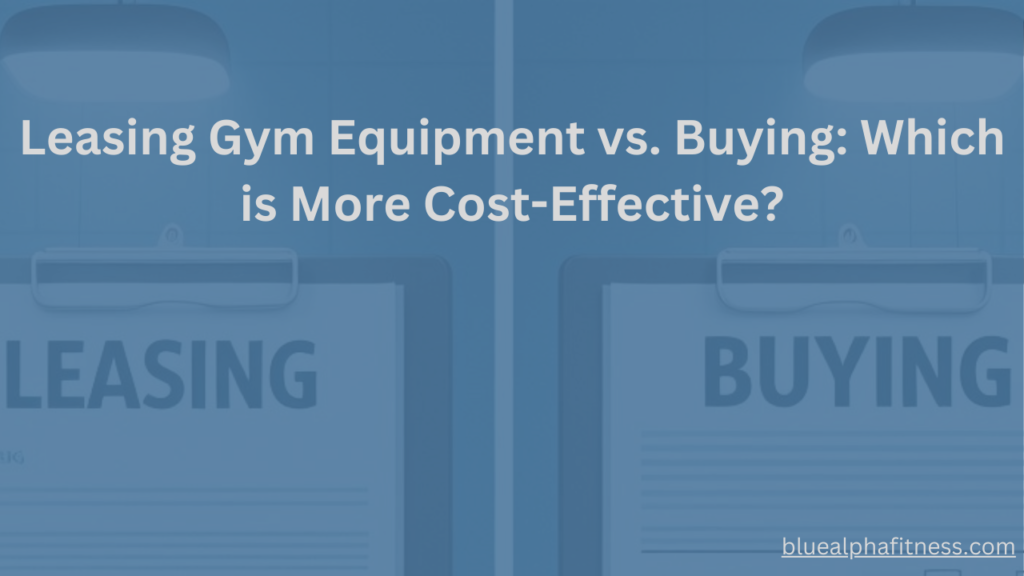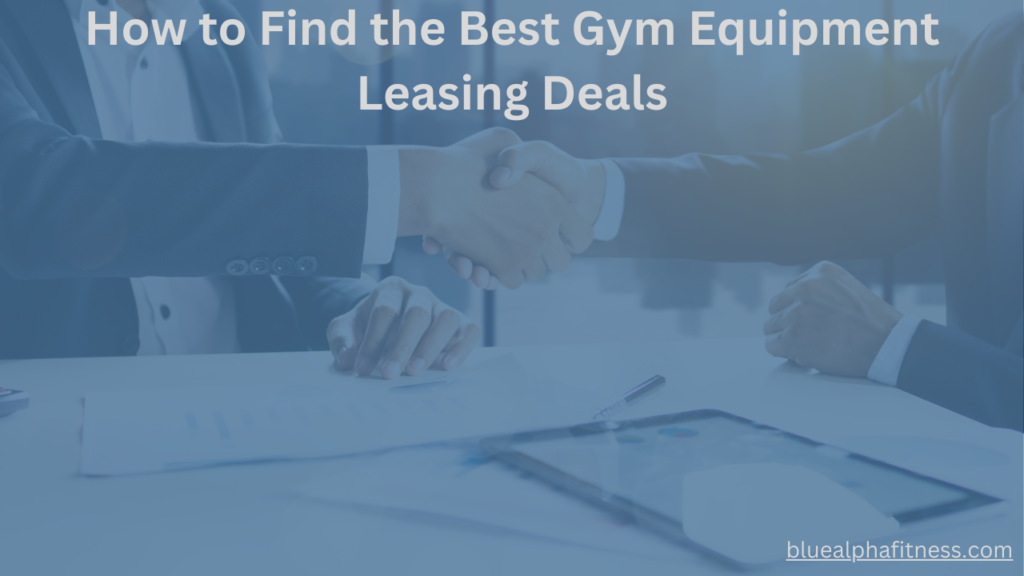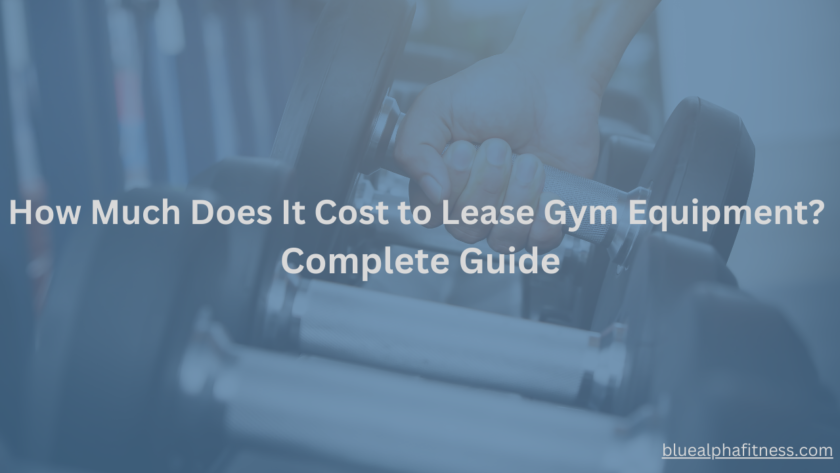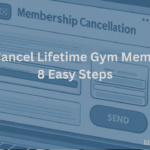Thinking about the cost to lease gym equipment but unsure if it’s the right move for you? You’re not alone.
Whether you’re opening a new gym or upgrading an existing one, the thought of committing to a lease can feel overwhelming. You might wonder if you’re signing up for a great deal or a money pit.
It’s totally normal to feel anxious—nobody wants to end up paying more than they bargained for.
So, how much does it cost to lease gym equipment? On average, leasing can range from $60 to $150 per month per piece, depending on the type of equipment, with some higher-end machines exceeding that range.
It’s not just about the numbers, though—lease terms, hidden fees, and the specific equipment all play a role.
In this article, we’ll break down leasing costs, compare leasing vs. buying, and show you how to get the best deal.
Ready? Let’s dive in!
How Much Does It Cost to Lease Gym Equipment? Explained
As mentioned earlier, the average cost to lease gym equipment falls between $60 and $150 per month, depending on factors like the equipment’s type, brand, and overall condition. Premium models may exceed this range.
Leasing gym equipment can be a game-changer, especially when you’re trying to keep costs low without skimping on quality.
But how does it stack up against buying?
When you lease, you’re essentially renting the equipment for a set period instead of owning it outright. This means you avoid the hefty upfront costs associated with buying new machines.
For a commercial gym, leasing can make financial sense, especially if you’re eyeing high-end equipment, such as:
- Treadmills
- Ellipticals
- Weight machines
These pieces could otherwise cost tens of thousands to buy.
Even personal training studios can benefit by leasing just a few key pieces instead of blowing their budget on new equipment.
Plus, leasing lets you upgrade when new models hit the market—no buyer’s remorse here.
What Factors Influence the Cost of Leasing Gym Equipment?
The factors influencing the cost of leasing gym equipment include the type of equipment, brand and model, lease term length, condition of the equipment, and any additional costs.
Understanding these elements can help you make informed decisions and find the best leasing options for your needs.
1. Equipment Type
Not all machines are priced equally.
Treadmills and ellipticals tend to be more expensive than simpler equipment like benches or dumbbells.
Specialty equipment, like Pilates reformers or functional trainers, can also add a premium to your monthly bill. The more complex the machinery, the higher the lease rate.
Think about it: leasing a high-tech, commercial-grade treadmill is going to cost more than a basic weight rack.
2. Brand and Model
Leasing rates vary widely between brands.
High-end, commercial-grade equipment like Life Fitness or Technogym will cost more than budget-friendly options.
It’s the same as choosing between a luxury car and a reliable sedan—both get the job done, but one’s going to feel a lot fancier.
Remember, though, that the brand you pick impacts not just price but durability and user experience.
Leasing high-end equipment might seem pricey, but it often saves on maintenance down the road.
3. Lease Term Length
The length of your lease can play a big role in your overall costs.
Short-term leases, typically 12 months, will often have higher monthly payments but offer more flexibility—ideal if you’re testing the waters or planning a short-term pop-up gym.
Longer leases (36-60 months) tend to lower your monthly rate, but they also lock you in.
The trade-off? A lower upfront monthly payment versus the risk of committing to gear that might not suit your needs long-term.
4. Condition of Equipment
Leasing new equipment will always come with a premium, but refurbished or used gear can save you a pretty penny.
If you’re willing to forgo the newest model, you could pay 30-50% less per month.
For example, a new elliptical might lease for $120 a month, whereas a refurbished one could cost only $70.
Just be sure to check the warranty and maintenance terms to avoid unexpected repair bills.
5. Additional Costs
Leasing isn’t always a flat rate—watch out for extra fees that can sneak up on you.
Maintenance fees, delivery charges, and insurance can add to your monthly cost.
For instance, some leases include routine maintenance, while others charge extra. Always ask what’s included; nobody likes surprise charges on their bill.
How Gym Equipment Leasing Works: Step-by-Step Guide
Leasing gym equipment is straightforward: identify your needs, explore suitable leasing companies, compare offers, and negotiate terms.
Once you finalize the agreement, manage your equipment effectively and consider your options at the lease’s end.

This guide simplifies each step for confident leasing.
Step 1: Identify Your Gym Equipment Needs
Start by identifying what your gym actually needs.
Are you running a full-scale commercial gym, a boutique studio, or a home setup?
List the essential equipment based on your target clientele.
For example, a personal training studio might prioritize functional trainers, while a commercial gym would need a wider range of cardio and strength machines.
Focus on what’s critical and avoid leasing equipment that won’t get much use.
Step 2: Research Leasing Companies
Not all leasing companies are created equal.
Do some digging—check reviews, ask for recommendations, and compare the terms they offer.
Some companies specialize in specific types of equipment or work primarily with commercial clients. Look for a company that matches your needs and offers transparent terms.
It’s like shopping for a car; you wouldn’t buy from the first dealership you walk into, right?
Step 3: Request Quotes and Compare Offers
Once you’ve narrowed down your options, request quotes.
This isn’t just about price; pay attention to the details.
What’s included in the lease? Are maintenance and repairs covered? Is there an option to upgrade during the term?
Gather multiple quotes and compare. It’s a bit like speed dating—you’re looking for the best fit, not just the best price.
Step 4: Review and Negotiate Lease Terms
Don’t just sign on the dotted line. Review the terms closely, and don’t hesitate to negotiate.
Ask for flexible terms, better maintenance packages, or even discounts on bulk leases if you’re outfitting an entire gym.
Leasing companies often have some wiggle room; it never hurts to ask.
Step 5: Finalize the Lease and Arrange Delivery
Once you’re satisfied with the terms, it’s time to sign and set up delivery.
Make sure the delivery logistics work for your timeline, and clarify any setup fees.
Double-check everything; the last thing you want is to be opening day and find out your treadmills are still in a warehouse.
Step 6: Manage Your Lease Effectively
Leasing isn’t a set-it-and-forget-it deal.
Regularly maintain your equipment, track your payments, and keep an eye on your lease’s terms for any upgrade options.
Managing these elements well ensures your equipment stays in top shape and prevents any nasty surprises.
Step 7: Explore End-of-Lease Options
When your lease is up, you’ve got choices.
You can renew the lease, return the equipment, or purchase it at a reduced price.
This flexibility can be a lifesaver, especially if your needs have changed or you’re looking to refresh your gym’s look with newer models.
Average Monthly Costs of Leasing Popular Gym Equipment
To help you get a better sense of what leasing costs might look like, here’s a breakdown of average monthly leasing rates by equipment type:
1. Treadmills
Treadmills are the bread and butter of any gym, but they don’t come cheap.
Leasing rates typically range from $100 to $200 per month, depending on the brand and model.
High-end commercial treadmills with interactive screens and heart rate monitoring will cost more, while basic models hover around the lower end of the spectrum.
2. Ellipticals
Leasing an elliptical generally costs between $90 and $160 per month.
Variations in cost depend on the model’s features, such as resistance levels, stride adjustments, and built-in programs.
Higher-end models designed for commercial use will drive up the price, but they often come with perks like better durability and customer support.
3. Strength Training Equipment
Benches, squat racks, and weight machines usually lease for $60 to $120 per month per piece.
A full strength training setup can quickly add up, especially if you’re looking for specialized machines like leg presses or cable crossovers.
For home gyms, simpler benches and racks can be leased for less, but commercial-quality equipment is generally worth the investment for heavier use.
4. Stationary Bikes & Spin Bikes
Monthly lease costs for stationary and spin bikes typically range from $60 to $150.
High-end models, such as those with interactive screens or brand-name recognition, will always cost more.
However, even a mid-range bike can offer a great cardio experience without breaking the bank.
5. Cost Differences for Commercial vs. Home Use Leasing
Commercial gyms often pay higher leasing rates due to the need for more durable, heavy-duty equipment.
Home-use leases tend to be cheaper but come with shorter warranty terms and less maintenance support.
It’s essential to weigh these factors when choosing between commercial-grade and home-use equipment.
Leasing Gym Equipment vs. Buying: Which is More Cost-Effective?
Generally, leasing gym equipment is more cost-effective compared to buying, especially when cash flow and flexibility are important.
However, both options come with their own benefits and considerations.

Here’s a side-by-side look at the key factors to help you decide which is the better choice for your gym:
1. Initial Investment
Buying gym equipment outright means a substantial upfront cost, often in the tens of thousands for a full gym setup.
Leasing, on the other hand, spreads that cost over time, making it easier on your cash flow.
For example, buying a set of commercial treadmills could cost $20,000 upfront, whereas leasing those same machines might only set you back $500 a month.
2. Long-Term Cost Analysis
Over time, buying can be cheaper, but it’s not always that simple.
Leasing allows you to budget predictably with fixed monthly payments and lets you upgrade to new models without selling off old equipment.
Plus, with leases, maintenance is often included—one less headache to worry about.
3. Flexibility in Upgrading
Leasing provides a unique advantage when it comes to keeping your equipment up-to-date.
Unlike buying, which leaves you stuck with aging gear, leasing allows for upgrades at the end of your term.
This flexibility means you can always offer clients the latest and greatest without additional out-of-pocket costs.
4. Ownership and Equity Considerations
Sure, owning equipment outright means you build equity, but it also means you bear the burden of repairs, depreciation, and the hassle of selling when you want to upgrade.
Leasing gives you the freedom to return outdated gear and switch it up without dealing with the resale market.
Lease-to-Own Gym Equipment: Is It Worth It?
Yes, lease-to-own agreements can be worth it if you want to eventually own your gym equipment without the upfront costs of buying in full.
Part of your monthly payment goes toward the purchase, allowing you to gradually invest in ownership.
Let’s take a closer look at how lease-to-own compares in terms of costs, benefits, and use cases.
1. Cost Comparison Between Traditional Leasing and Lease-to-Own Options
Lease-to-own usually has higher monthly payments compared to traditional leasing.
However, if your goal is to eventually own the equipment, it can be a cost-effective route.
For example, instead of paying $100 per month on a standard lease, you might pay $150 on a lease-to-own agreement, with a chunk of that going toward ownership.
2. Benefits and Drawbacks of Lease-to-Own Arrangements
Lease-to-own offers the best of both worlds—lower upfront costs and eventual ownership.
However, you’ll likely pay more over time than if you had purchased outright from the start.
Plus, you’re locked into the specific equipment, which can be a downside if you decide you want a different model.
3. Best Scenarios for Choosing a Lease-to-Own Plan
Lease-to-own works well if you’re certain the equipment fits your long-term needs.
For personal trainers or small studios with consistent clientele, it’s a great way to gradually own equipment without the upfront investment.
However, for rapidly growing commercial gyms that frequently update their equipment, traditional leasing might offer better flexibility.
Leasing Gym Equipment for Commercial Gyms: Costs and Considerations
For commercial gyms, leasing is often the go-to option.
Why? It’s flexible, scalable, and keeps you stocked with top-tier equipment without the financial strain.
1. Why Leasing Is Popular for Commercial Gym Setups
Leasing is appealing for commercial gyms because it minimizes the initial capital outlay.
Instead of pouring thousands into buying, gyms can use that money for other needs like marketing, staffing, or facility upgrades.
Plus, leasing allows gyms to maintain a fresh look with the latest gear—something that keeps members coming back.
2. Estimating Monthly Costs for Fully Equipping a Gym
Outfitting a commercial gym with leased equipment can cost anywhere from $5,000 to $15,000 per month, depending on the size and scale of your operation.
This includes cardio machines, strength training equipment, and specialty items like spin bikes or rowers.
While that may seem steep, compare it to the hundreds of thousands it would take to purchase everything in full.
3. Bulk Leasing Discounts: Saving Money When Leasing Multiple Pieces of Equipment
Many leasing companies offer bulk discounts if you’re leasing a large number of items.
For example, leasing ten treadmills might cost less per unit than leasing just one.
Always ask about discounts—it’s a great way to lower your overall costs.
4. Maintenance Contracts and Service Agreements in Leasing Contracts
Maintenance is a crucial factor that often tips the scales in favor of leasing for commercial gyms.
Most leases include maintenance and repair services, ensuring that your equipment stays operational and safe for users.
This is a huge plus since equipment downtime can mean lost revenue and unhappy members.
How to Find the Best Gym Equipment Leasing Deals
To find the best gym equipment leasing deals, start by researching companies that specialize in gym equipment leasing.
Look for firms with solid reviews, transparent pricing, and a reputation for good customer service.
Word of mouth is powerful—ask fellow gym owners about their experiences to get the most honest feedback.

1. Negotiate Lease Terms: Tips for Reducing Costs and Getting Favorable Terms
Once you’ve identified some leasing options, the next step is negotiation.
Don’t settle for the first quote you get. Leasing terms are often negotiable.
Ask for reduced monthly rates, flexible term lengths, or added maintenance services. If you’re leasing multiple pieces, leverage that for bulk discounts.
Negotiation isn’t just for cars—you’ve got more power than you think.
2. Compare Offers: Evaluate Multiple Leasing Options to Find the Best Deal
After negotiating, it’s time to compare your options.
Gather quotes from several leasing companies and line them up side by side. Look beyond the monthly cost.
Consider what’s included—maintenance, upgrades, insurance—and weigh the total package.
A slightly higher monthly rate could be worth it if it covers more services.
3. Read and Understand Leasing Contracts: Hidden Fees and Fine Print to Look Out For
Finally, before signing any lease, always read the fine print.
Hidden fees, like early termination penalties or extra maintenance costs, can turn a great deal into a costly mistake.
Make sure you understand every aspect of the lease, including what happens at the end of the term.
Common Mistakes to Avoid When Leasing Gym Equipment
The common mistakes to avoid when leasing gym equipment include not reading the fine print, underestimating needs, ignoring maintenance, locking into long-term contracts, and not comparing offers.
Let’s explore how you can avoid these pitfalls and make smarter leasing decisions.
1. Not Reading the Fine Print
Always read your lease contract carefully.
Hidden fees, stringent maintenance clauses, or unfavorable end-of-term conditions can sneak up on you.
Understanding your contract fully is key to avoiding nasty surprises.
2. Underestimating Equipment Needs
Don’t just lease the basics; think about what your clients actually use.
Leasing too little can lead to overcrowded machines, while leasing too much ties up cash unnecessarily.
Plan carefully based on your gym’s usage patterns.
3. Ignoring Maintenance Costs
Maintenance isn’t always included in your lease.
Skipping regular service can lead to costly repairs and equipment downtime.
So, make sure you know who’s responsible for upkeep and factor it into your budget.
4. Locking into Long-Term Contracts Too Early
Long-term leases might look appealing with their lower monthly rates, but they can backfire if your needs change.
Be cautious about committing to long terms unless you’re confident in your equipment choices.
5. Not Comparing Lease Offers
Don’t accept the first lease offer you receive.
Comparing multiple offers lets you see the market rate and negotiate better terms.
Just like any big purchase, a little homework can save you a lot of money.
FAQs: How Much Does It Cost to Lease Gym Equipment? Your Top Questions Answered
Understanding how much it costs to lease gym equipment is crucial for making informed decisions.
In this FAQ section, I answer your essential questions about leasing terms, payment options, and potential hidden costs.
1. How does leasing gym equipment work?
Leasing gym equipment involves signing a contract to use the equipment for a specified time in exchange for monthly payments.
2. Can I lease gym equipment with no credit or bad credit?
Yes, you can lease gym equipment with no credit or bad credit, but expect higher interest rates and stricter terms.
3. How does leasing gym equipment affect my gym’s cash flow?
Leasing improves your gym’s cash flow by spreading costs over time, avoiding large upfront payments.
4. What happens if my leased gym equipment gets damaged or breaks down?
If your leased gym equipment gets damaged, you may be responsible for repairs unless maintenance is included in your lease.
5. Are there any hidden costs when leasing gym equipment?
Yes, hidden costs can include maintenance fees, early termination penalties, and insurance requirements.
6. Can I lease gym equipment internationally?
Yes, you can lease gym equipment internationally, but it depends on the leasing company’s policies and logistics.
7. Is there a minimum or maximum amount of equipment I can lease?
There is typically no strict minimum, but some companies may have maximum limits based on your financial standing.
8. How does leasing gym equipment impact my gym’s financial statements?
Leasing gym equipment is often recorded as an operating expense, which can lower reported net income but keep liabilities off your balance sheet.
9. What is a fair market value lease for gym equipment?
A fair market value lease allows you to return the equipment at the end of the lease term or purchase it at its market value.
10. Can I lease gym equipment for a short-term pop-up gym or event?
Yes, you can lease gym equipment for short-term events, though terms may vary based on the lease duration.
11. Do I need insurance when leasing gym equipment?
Yes, you need insurance when leasing gym equipment to cover potential damages or losses.
12. What is the typical approval process for leasing gym equipment?
The typical approval process involves a credit check, financial review, and submission of business information, often taking a few days to complete.
13. Can I add more equipment to my lease after the agreement has started?
Yes, you can add more equipment, but it may require a contract amendment or new lease terms.
14. How do lease payments for gym equipment work?
Lease payments are typically monthly and can vary based on the equipment value, lease length, and terms agreed upon.
15. Is there a penalty for exceeding the usage limits on leased gym equipment?
Yes, exceeding usage limits can result in penalties or extra charges depending on your lease terms.
16. What warranties are typically included when leasing gym equipment?
Warranties often include coverage for manufacturing defects and basic maintenance during the lease term.
17. Can I customize leased gym equipment with my gym’s branding?
Yes, you can often customize leased gym equipment, but modifications usually need approval from the leasing company.
18. Are there leasing options for boutique fitness studios with specific equipment needs?
Yes, leasing companies offer tailored options for boutique fitness studios with niche equipment requirements.
19. What should I look for in a gym equipment leasing contract?
Look for clear terms on payment schedules, maintenance responsibilities, end-of-lease options, and potential hidden fees.
20. Can I trade in my leased gym equipment for newer models?
Yes, some leases allow trade-ins for newer models, usually as part of an upgrade or lease renewal agreement.
Final Word on the Cost of Leasing Gym Equipment
Deciding how much it costs to lease gym equipment isn’t just about numbers—it’s about finding what fits your vision.
You might wonder, “Is leasing the smartest choice for my gym?”
It’s natural to feel torn between new equipment and the worry of hefty upfront costs. But leasing offers lower initial expenses, flexible terms, and the chance to upgrade easily, keeping your gym fresh and competitive.
Understanding leasing costs can empower your big dreams.
It’s not just about saving money; it’s about staying agile and making choices that pave the way for long-term success.
Explore your leasing options today and unlock the full potential of your gym—you’ve got this!



